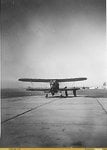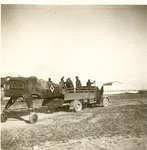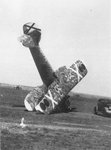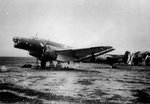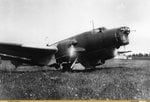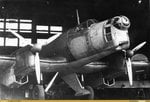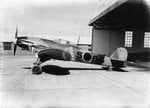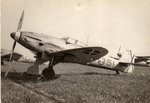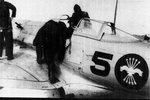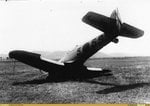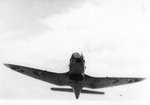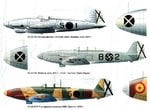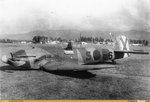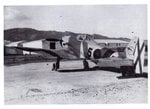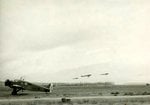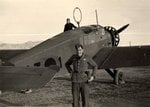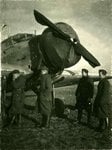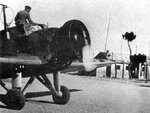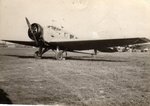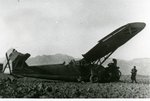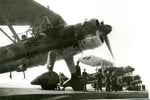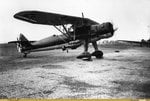- Thread starter
- #61
Navigation
Install the app
How to install the app on iOS
Follow along with the video below to see how to install our site as a web app on your home screen.
Note: This feature may not be available in some browsers.
More options
You are using an out of date browser. It may not display this or other websites correctly.
You should upgrade or use an alternative browser.
You should upgrade or use an alternative browser.
Spanish Civil War: Nationalist Air Force
- Thread starter gekho
- Start date
Ad: This forum contains affiliate links to products on Amazon and eBay. More information in Terms and rules
More options
Who Replied?Nice shots!
- Thread starter
- #63
- Thread starter
- #64
In 1934, a specification for a modern twin-engined aircraft capable of operating both as a high speed airliner for the German airline Lufthansa and as a medium bomber for the still-secret Luftwaffe was issued to both Junkers and Heinkel. Five prototypes were ordered from each company; the Junkers Ju 86 and Heinkel He 111. Junkers design was a low-winged twin engined monoplane, of all-metal Stressed skin construction. Unlike most of Junkers previous designs, it discarded their typical corrugated skinning in favour of smooth metal skinning which helped to reduce drag. The craft was fitted with a narrow track retractable tailwheel undercarriage and twin fins and rudders. It was intended to be powered by the Junkers Jumo 205 diesel engines, which although heavy, gave superior fuel consumption to conventional petrol engines.
The first prototype Ju 86, the Ju 86ab1, fitted with Siemens SAM 22 radial engines as airworthy Jumo 205s were unavailable, flew on 4 November 1934, in bomber configuration, with the second prototype, also a bomber, flying in January 1935. The third Ju 86, and the first civil prototype, flew on 4 April 1935. Production of pre-series military and civil aircraft started in late 1935, with full production of the Ju 86A-1 bomber commencing in April 1936. Production quickly switched to the improved Ju 86 D with a modified tail cone to impove stability. Early use of the Jumo powered Ju 86 bomber over Spain showed that it was inferior to the He 111, with the diesel engines being unsuitable for rough treatment during combat, and production plans were cut back. One Ju 86 had already been converted to use radial engines as a testbed for possible export versions, and this showed much improved reliability, and production was switched to a version powered by the BMW 132 engine, the Ju 86E, production continuing until 1938.
The bomber was field tested in the Spanish Civil War, where it proved inferior to the Heinkel He 111. Four Ju 86D-1 arrived in Spain in early February 1937, but after a few sorties one of them (coded 26-1) was shot down on 23 February by Republican fighters with the loss of three crewmen killed and one captured. A replacement aircraft was sent from Germany, but in the summer of 1937 another D-1 was lost in an accident, and the three remaining planes were sold to the Nationalist air forces.
The first prototype Ju 86, the Ju 86ab1, fitted with Siemens SAM 22 radial engines as airworthy Jumo 205s were unavailable, flew on 4 November 1934, in bomber configuration, with the second prototype, also a bomber, flying in January 1935. The third Ju 86, and the first civil prototype, flew on 4 April 1935. Production of pre-series military and civil aircraft started in late 1935, with full production of the Ju 86A-1 bomber commencing in April 1936. Production quickly switched to the improved Ju 86 D with a modified tail cone to impove stability. Early use of the Jumo powered Ju 86 bomber over Spain showed that it was inferior to the He 111, with the diesel engines being unsuitable for rough treatment during combat, and production plans were cut back. One Ju 86 had already been converted to use radial engines as a testbed for possible export versions, and this showed much improved reliability, and production was switched to a version powered by the BMW 132 engine, the Ju 86E, production continuing until 1938.
The bomber was field tested in the Spanish Civil War, where it proved inferior to the Heinkel He 111. Four Ju 86D-1 arrived in Spain in early February 1937, but after a few sorties one of them (coded 26-1) was shot down on 23 February by Republican fighters with the loss of three crewmen killed and one captured. A replacement aircraft was sent from Germany, but in the summer of 1937 another D-1 was lost in an accident, and the three remaining planes were sold to the Nationalist air forces.
Attachments
Last edited:
- Thread starter
- #65
- Thread starter
- #66
- Thread starter
- #67
- Thread starter
- #68
Seeking a replacement for the Heinkel He 51 and Arado Ar 68 biplane fighters, the Reichsluftfahrtministerium issued in 1933 a specification for a monoplane, drawing submissions from Arado, Focke-Wulf, Heinkel and Messerschmitt. The prototype Heinkel He 112 was evaluated competitively with the three other designs at Travemunde in October 1935 and both it and Messerschmitt's Bf 109 received orders for 10 aircraft. Powered by a 518kW Rolls-Royce Kestrel V engine, the prototype was followed by two further aircraft with reduced-span wings and 447kW Jumo 210C engines. The fourth prototype, with a new elliptical wing, was evaluated operationally with the Legion Condor in Spain in 1936, and was shown at the July 1937 Zurich International Flying Meeting. The proposed He 112A production aircraft was not adopted by the Luftwaffe, which received the Bf 109 instead, but work continued on the structurally-redesigned He 112B, the 507kW Jumo 210Ea-powered production prototype which flew in July 1937. Twelve of 30 aircraft ordered by Japan were delivered in the spring of 1938, but the next 12 were impressed for Luftwaffe use, although 11 of these and the final six were supplied later to the Spanish Nationalist air force in November 1938. Thirteen He 112B-0 and 11 He 112B-1 aircraft were delivered to the Romanian air force, the order being completed in September 1939, and three He 112B-1s were acquired by the Hungarian air force in the spring of 1939. Armament of the He 112B series was two wing-mounted 20mm MG FF cannon and two 7.92mm MG 17 machine-guns in the upper engine cowling.
Attachments
Last edited:
- Thread starter
- #69
When it was clear the 112 was losing the contest to the Bf 109, Heinkel offered to re-equip V6 with 20 mm cannon armament as an experimental aircraft. She was then broken down and shipped to Spain on 9 December and assigned to Versuchsjagdgruppe 88, a group within the Legion Condor devoted to testing new aircraft and joined three V series Bf 109s which were also in testing. Oberleutnant Wilhelm Balthasar used it to attack an armoured train and an armoured car. Other pilots flew it, but the engine seized during landing in July and she was written off.
The Spanish government purchased 12 112Bs. This increased to 19. The He 112s were to operate as top cover for Fiat fighters in the opening stages of the Civil War, the Fiat having considerably worse altitude performance. In the event, only a single kill was made with the He 112 as a fighter and it was moved onto ground-attack work. During World War II, when Allied forces landed in North Africa, Spanish forces in Morocco intercepted stray aircraft of both Allied and German forces. None of these incidents resulted in losses. In 1943, one He 112 of Grupo nº27 attacked the tail-end of the aircraft of 11 Lockheed P-38s forcing it down in Algeria after reentering French territory after crossing into Spanish Morroco. By 1944, the aircraft were largely grounded due to a lack of fuel and maintenance.
The Spanish government purchased 12 112Bs. This increased to 19. The He 112s were to operate as top cover for Fiat fighters in the opening stages of the Civil War, the Fiat having considerably worse altitude performance. In the event, only a single kill was made with the He 112 as a fighter and it was moved onto ground-attack work. During World War II, when Allied forces landed in North Africa, Spanish forces in Morocco intercepted stray aircraft of both Allied and German forces. None of these incidents resulted in losses. In 1943, one He 112 of Grupo nº27 attacked the tail-end of the aircraft of 11 Lockheed P-38s forcing it down in Algeria after reentering French territory after crossing into Spanish Morroco. By 1944, the aircraft were largely grounded due to a lack of fuel and maintenance.
Attachments
- Thread starter
- #70
- Thread starter
- #71
- Thread starter
- #72
More pics
Attachments
-
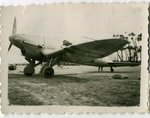 Heinkel%20He-112%200021.jpg107.8 KB · Views: 286
Heinkel%20He-112%200021.jpg107.8 KB · Views: 286 -
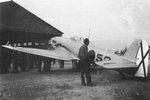 Heinkel%20He-112%200025.jpg94.1 KB · Views: 275
Heinkel%20He-112%200025.jpg94.1 KB · Views: 275 -
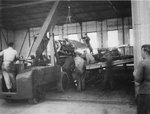 Heinkel%20He-112%200024.jpg112.3 KB · Views: 276
Heinkel%20He-112%200024.jpg112.3 KB · Views: 276 -
 Heinkel%20He-112%200022.jpg72.2 KB · Views: 286
Heinkel%20He-112%200022.jpg72.2 KB · Views: 286 -
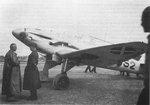 Heinkel%20He-112%200023.jpg107.4 KB · Views: 291
Heinkel%20He-112%200023.jpg107.4 KB · Views: 291 -
 avc_00274375.jpg79 KB · Views: 503
avc_00274375.jpg79 KB · Views: 503 -
 avc_00167009.jpg89.4 KB · Views: 236
avc_00167009.jpg89.4 KB · Views: 236
Last edited:
- Thread starter
- #73
Junkers W 34 was a German-built, single-engine, passenger and transport aircraft. Developed in the 1920s, it was taken into service in 1926. The passenger version could take a pilot and five passengers. The aircraft was developed from the Junkers W 33. Further development led to the Junkers Ju 46. W33/W34s were used for a wide range of purposes, e.g. as transport, reconnaissance or bomber aircraft, but also as ambulance and pest control aircraft. They were used by operators on all five continents. The Dessau W33 production was stopped during 1932. At Limhamn some K43s were still built in 1933, when production was stopped there. The last W33s were built in Russia during late 1934 / early 1935.
In 1933 Luftwaffe again ordered a larger number of W34s, which were delivered until 1935. These aircraft were later used during the Spanish Civil War by Legion Condor. The 8 Junkers W.34 delivered to Spain to support the Legion Condor were mainly used as (personal) transports, navigational trainers or used for weather forecasting. They all bore the military serials 43o?, from 1946 onwards replaced by the code L.14 (82o??) and some of them continued in service until the 1950s.
In 1933 Luftwaffe again ordered a larger number of W34s, which were delivered until 1935. These aircraft were later used during the Spanish Civil War by Legion Condor. The 8 Junkers W.34 delivered to Spain to support the Legion Condor were mainly used as (personal) transports, navigational trainers or used for weather forecasting. They all bore the military serials 43o?, from 1946 onwards replaced by the code L.14 (82o??) and some of them continued in service until the 1950s.
Attachments
Last edited:
- Thread starter
- #74
More pics
Attachments
-
 JunkersW-34nr43-3svlfotoCONDORPatri.jpg69.9 KB · Views: 292
JunkersW-34nr43-3svlfotoCONDORPatri.jpg69.9 KB · Views: 292 -
 JunkersW-34nr43-2svlfotoCONDORPatri.jpg102.2 KB · Views: 319
JunkersW-34nr43-2svlfotoCONDORPatri.jpg102.2 KB · Views: 319 -
 JunkersW-34nr43-3sarfotoCONDORPatri.jpg98.2 KB · Views: 297
JunkersW-34nr43-3sarfotoCONDORPatri.jpg98.2 KB · Views: 297 -
 JunkersW-34nr43-4salfotoCONDORPatri.jpg67.6 KB · Views: 298
JunkersW-34nr43-4salfotoCONDORPatri.jpg67.6 KB · Views: 298 -
 JunkersW-34nr43-5salfotoCONDORPatri.jpg113.7 KB · Views: 287
JunkersW-34nr43-5salfotoCONDORPatri.jpg113.7 KB · Views: 287
Last edited:
- Thread starter
- #75
More pics
Attachments
-
 JunkersW-34nr43-7salfotoCONDORPatri.jpg74.2 KB · Views: 299
JunkersW-34nr43-7salfotoCONDORPatri.jpg74.2 KB · Views: 299 -
 JunkersW-34nr43--svrmetmonteurfotob.jpg61.8 KB · Views: 291
JunkersW-34nr43--svrmetmonteurfotob.jpg61.8 KB · Views: 291 -
 JunkersW-34nr43--svrgfotoLegionCond.jpg53.5 KB · Views: 290
JunkersW-34nr43--svrgfotoLegionCond.jpg53.5 KB · Views: 290 -
 JunkersW-34nr43-8salfotoAERONETGCEf.jpg82.9 KB · Views: 295
JunkersW-34nr43-8salfotoAERONETGCEf.jpg82.9 KB · Views: 295 -
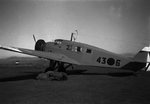 JunkersW-34nr43-6salfotobijgewerktA.jpg49.1 KB · Views: 278
JunkersW-34nr43-6salfotobijgewerktA.jpg49.1 KB · Views: 278
Last edited:
- Thread starter
- #76
- Thread starter
- #77
The Henschel Hs 126 was a German two-seat reconnaissance and observation aircraft of World War II that was derived from the Henschel Hs 122. The pilot was seated in a protected cockpit under the parasol wing and the gunner in an open rear cockpit. The prototype aircraft frame was that of a Hs 122A fitted with a Junkers engine. The Hs 126 was well received for its good short takeoff and low-speed characteristics which were needed at the time. It was put into service for a few years, but was soon superseded by the general-purpose, STOL Fieseler Fi 156 Storch and the medium-range Focke-Wulf Fw 189 "flying eye".
The first prototype was not entirely up to Luftwaffe standards; it was followed by two more development planes equipped with different engines. Following the third prototype, ten pre-production planes were built in 1937. The Hs 126 entered service in 1938 after operational evaluation with the Legion Kondor contingent to the Spanish Civil War.
The first prototype was not entirely up to Luftwaffe standards; it was followed by two more development planes equipped with different engines. Following the third prototype, ten pre-production planes were built in 1937. The Hs 126 entered service in 1938 after operational evaluation with the Legion Kondor contingent to the Spanish Civil War.
Attachments
-
 Henschel Hs-126 Superpava 003.jpg85.5 KB · Views: 427
Henschel Hs-126 Superpava 003.jpg85.5 KB · Views: 427 -
 Henschel Hs-126 Superpava 001.jpg82.6 KB · Views: 446
Henschel Hs-126 Superpava 001.jpg82.6 KB · Views: 446 -
 Henschel Hs-126 Superpava 002.jpg119 KB · Views: 426
Henschel Hs-126 Superpava 002.jpg119 KB · Views: 426 -
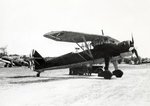 HS126IV.jpg69 KB · Views: 429
HS126IV.jpg69 KB · Views: 429 -
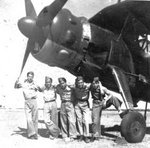 13207609.jpg117.2 KB · Views: 340
13207609.jpg117.2 KB · Views: 340 -
 avc_00314810.jpg81.8 KB · Views: 234
avc_00314810.jpg81.8 KB · Views: 234 -
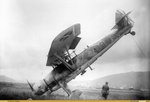 avc_00314759.jpg73.3 KB · Views: 209
avc_00314759.jpg73.3 KB · Views: 209
Last edited:
Good stuff!
- Thread starter
- #79
- Thread starter
- #80
Users who are viewing this thread
Total: 1 (members: 0, guests: 1)



